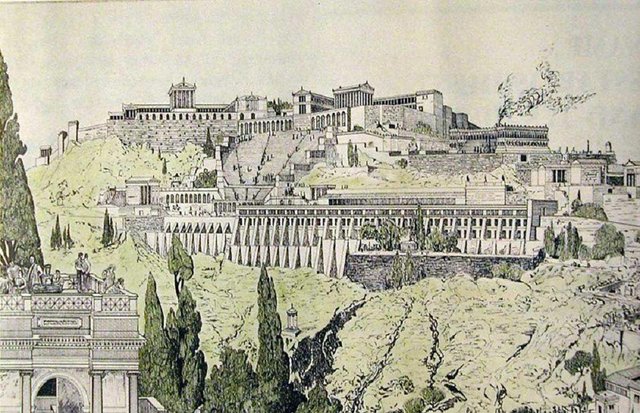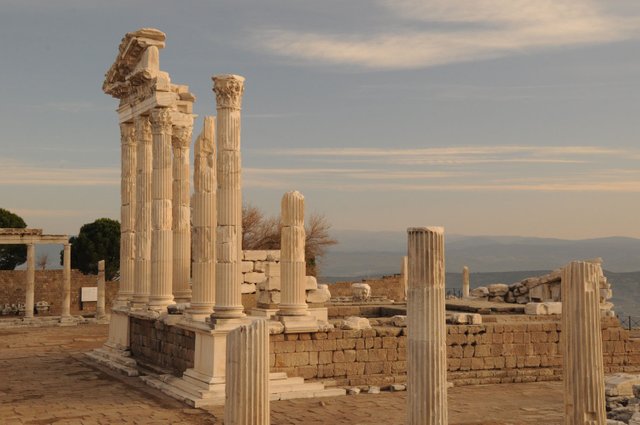The Library of Pergamon in todays Bergama, Republic of Turkey
After the death of Alexander the Great (323 BC), the great empire that he had built falls into the Diadochi kingdom:
Macedonia under the Antigonids (until 168 BC),
Syria, Babylonia, Persia under the Seleucids (until 63 BC),
Egypt under the Ptolemies (until 30 BC) and Pergamon under the Attalids (until 133 BC),
while in Greece the Aetolian and the Archaic Covenants are formed.
Characteristic of the Hellenistic culture is the promotion of the sciences by the Diadoches, whereby beside Athens Alexandrien and Pergamon develop as centers of the arts and the sciences. Probably around 295 BC In Alexandria under Ptolemy I, following the model of the Museion of the Platonic Academy and the Athenian Lykeion of Aristotle, the Museion was established, a kind of academy of science and the arts, in which, as the Greek name implies acted a music cult club; the priest of the Muses was at the same time the head of the Museion.
The Museion was located within the Royal Palace of Alexandria in the district of Brucheion. The scholars living there devoted themselves to research, poetry and teaching and wrote fundamental works in the fields of chronology, geography, mathematics, astronomy, medicine, philology and literary history. Attalos I of Pergamon (241-197) also brought scholars of various disciplines and visual artists to his court. The result was the Pergamen school as competition to Museion, the Alexandrian school.
Hellenism is the birth of philology as an independent scientific discipline. The philologists of the Alexandrian Museions tried to restore the original text of a work by means of several copies in the library using the text-critical method. To this principle of analogy, the Pergamenians opposed the anomaly; H. they simply left unintelligibilities in the texts untouched. At a time when science and research flourished, Hellenistic library foundations are understandable. For them, in comparison to the former libraries, they are distinguished not only by their greater scope, but also by the fact that they are public libraries as a foundation of state power, which in turn became exemplary for the founding of Roman public libraries are .
The supply of literature served the Library of Alexandria, which was attached to Museion and was founded under Ptolemy I or Ptolemy II's successor. In research they are considered in almost all respects (library construction, catalogs, etc.) as a great role model for the library of the Attalids in Pergamon. Ptolemy I and Ptolemy II are also considered the founders of the Serapeion Library, the Serapis Shrine, which was also located in Alexandria and is said to be the daughter of the Great Library, as the duplicates / duplicates of the "Great Library" of the Museion received.


Bergama is such an impressive place!
Next time I'll also visit the Asklepion, because lots of people tell me that it's great, too! :) Thank you for the explanation! :)
you are welcome @caravanci :)